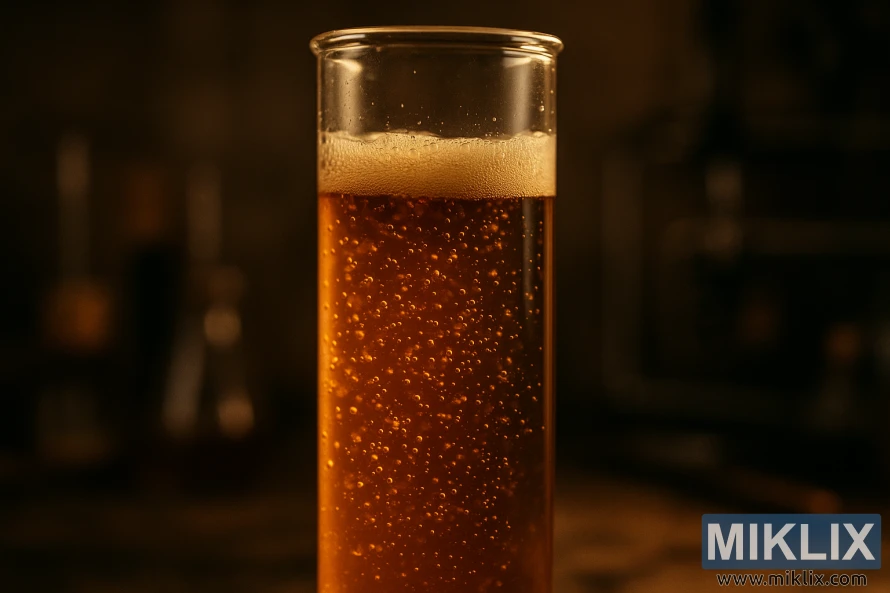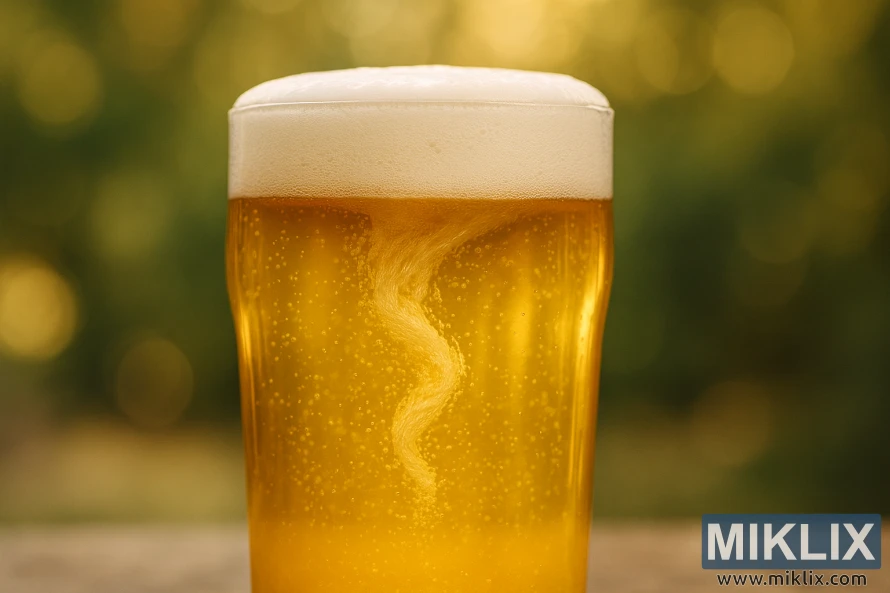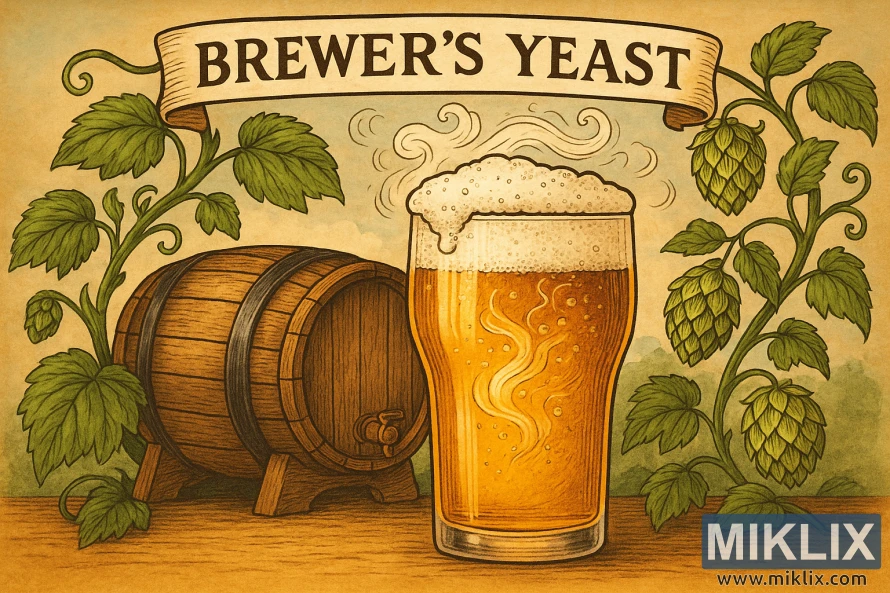Fermenting Beer with CellarScience Origin Yeast
Published: November 14, 2025 at 4:55:09 PM UTC
Last updated: November 14, 2025 at 4:55:59 PM UTC
This article delves into CellarScience Origin Yeast, a product for homebrewers and small commercial brewers. It examines Origin’s claims of a neutral base character, high-alcohol tolerance, and versatility in fermenting with sugar, honey, and malt.

Key Takeaways
- CellarScience Origin Yeast is positioned as a neutral, high-alcohol tolerant yeast for versatile fermentations.
- This Origin yeast review summarizes manufacturer specs, forum feedback, and industry context.
- Coverage includes packaging, dosage, temperature management, and performance on sugar, honey, and malt.
- Practical pitching, oxygenation, and nutrient/pH guidance are included to aid consistent fermentation.
- Useful for brewers targeting hard seltzers, neutral washes, canned cocktails, and honey meads.
What is CellarScience Origin Yeast
CellarScience's Origin is a dry yeast designed for neutral fermentation. It's favored by bakers, brewers, and distillers for its clean taste. This makes it perfect for adding layers of flavor without interference.
The yeast is known for its high alcohol tolerance and minimal ester production. It resists H2S and performs well at warmer temperatures up to 80°F (27°C). This makes it ideal for hard seltzers, canned cocktails, and neutral washes for distillation.
The package includes a neutral yeast strain, non-urea-based nutrients, and pH buffers. These components aid fermentation in low-nutrient media like simple sugar syrups and honey. They help prevent stuck ferments and ensure fermentation completes.
CellarScience emphasizes the quality and control over flavor that Origin offers. They avoid the term "Turbo Yeast," focusing instead on consistent performance. The inclusion of pH buffers is a key feature, often missing in fast-ferment mixes.
Origin is part of MoreFlavor Inc./MoreBeer's dry yeast range. The brand champions a Dry Yeast Revolution. They aim to provide homebrewers and small producers with reliable, shelf-stable yeast for both neutral and specialty fermentations.
Why choose dry yeast for homebrewing
Homebrewers often prefer dry yeast for its simplicity. It eliminates the complexities of a small-scale brew day. Dry yeast offers advantages such as no refrigerated shipping needs, easier storage, and a longer shelf life. These benefits make packing, transport, and inventory management straightforward for hobbyists and club brewers.
Cost is a significant factor when comparing dry vs liquid yeast. Dry packets are generally cheaper per pitch, reducing the need for starters or extra equipment. This cost-effectiveness allows brewers to experiment with more recipes without a significant investment in yeast logistics.
Modern dry strains from suppliers like CellarScience and MoreBeer are designed for robust performance. Many can be pitched directly without rehydration or forced oxygenation of the wort. This reduces the risk of process errors and supports consistent results, even in less technical setups.
Practical benefits of dry yeast include predictable attenuation and stable storage at room temperature. Homebrewers experience steady fermentations and consistent flavor outcomes with trusted dry strains. This reliability aids in recipe development and scaling.
When deciding between dry and liquid yeast, consider convenience and shelf stability against the flavor nuances of liquid strains. For most hobbyists, the advantages of dry yeast — affordability, ease of use, and wide strain availability — make it the preferred choice for everyday brewing.
CellarScience Origin Yeast packaging and dosage guidance
CellarScience offers Origin in single-use packets for direct pitching. Each packet includes dry yeast, nutrients, and pH buffers. This allows for easy addition to wort without hydration.
For initial trials, follow the Origin directions: add 10 to 20 g per gallon (2.5 to 5 g per liter) directly into fermentation. The recommended starting dosage is 15 g per gallon (4 g per liter) for most ales.
After pilot batches, adjust the Origin yeast dosage to fine-tune attenuation and flavor for your recipe. Small test ferments help understand how the strain handles different gravities and fermentables.
- Single-use packets for direct pitching ease handling and sanitation.
- Built-in nutrients and pH buffers improve reliability across batches.
- Room-temperature stock and value pricing from MoreBeer and CellarScience make sourcing simple.
Refer to the CellarScience packaging and technical data sheet for full specifications and storage guidance. Brewers should treat the directions as starting points. They should refine dosages to meet target attenuation and sensory goals.
Fermentation temperature ranges and management
CellarScience recommends fermenting Origin between 65–80°F (18–27°C). Fermenting at 65–70°F results in a clean, neutral flavor. For a quicker fermentation or a more alcohol-forward beer, aim for the higher end of the range.
The homebrew community shares experiences with Origin's temperature behavior. Strains like Nectar have shown warm activity, with temperatures ranging from 64–72°F. Sometimes, the temperature can spike up to 74°F during peak fermentation. This highlights the need for close monitoring, especially in high-gravity or nutrient-rich worts.
Origin is rich in nutrients and performs well on sugar or honey. High-gravity ferments or heavy pitching can lead to significant exothermic activity. It's crucial to track the fermenter's core temperature, as ambient readings often underestimate the actual temperature.
Effective temperature management for Origin includes ambient control, swamp coolers, and switched refrigeration for larger vessels. Fermenting at 80°F accelerates attenuation and intensifies ester profiles. Be prepared to cool the fermenter if temperatures exceed your target.
Follow these practical steps:
- Place a thermometer at the fermenter core to catch exotherms early.
- Employ dry ice, a small refrigerator, or a glycol chiller for precise control.
- Move the fermenter to a cooler spot or use evaporative cooling for minor adjustments.
- Lower pitching temperature to give the yeast room to warm into the range rather than spiking.
Keep detailed records of starting gravity, ambient conditions, and core temperatures. This data aids in predicting heat generation in future batches and refines your temperature management strategy for Origin.
Attenuation expectations and achieving a dry finish
CellarScience presents Origin as a yeast strain capable of tolerating high alcohol levels. It can achieve strong attenuation with the right conditions. For sucrose or honey-based media, the included nutrients and pH buffers enhance sugar conversion. This increases the likelihood of full attenuation.
When using malt, aim for a drier outcome by incorporating CellarScience Brutzyme glucoamylase. This enzyme breaks down dextrins into fermentable sugars. This allows the yeast to ferment beyond its usual limits, supporting a dry finish.
The final attenuation is influenced by dosage, temperature, and pitching rate. Adhere to the manufacturer's dosage recommendations and use the yeast nutrient to prevent stalled fermentations in nutrient-poor worts. Lower pitching rates and cooler temperatures tend to lower attenuation. Conversely, adequate pitch and warm, controlled temperatures typically increase it.
Community feedback reveals variability among CellarScience strains and recipes. A homebrewer achieved about 76% attenuation in a 1.043 stout fermented at 68–72°F. Expect attenuation levels to range from mid-60s to mid-80s percent. This depends on the fermentable type, enzyme application, and process control.
- For sugar or honey: follow nutrient and pH buffer instructions to push toward achieving full attenuation.
- For malt worts: add Brutzyme glucoamylase if you want a very dry finish with Origin.
- For reliable results: monitor gravity, maintain stable temperatures, and ensure adequate oxygen at pitching.
Thorough planning leads to predictable outcomes. Align fermentable selection, enzyme application, and pitching practices with your desired attenuation. This will enhance the chances of a clean, drier beer that meets style expectations with Origin attenuation.

Performance on different fermentables: sugar, honey, and malt
CellarScience Origin shows versatility with various fermentables. It excels with sucrose, dextrose, and liquid invert sugar, especially in nutrient-poor musts. The formulation's non-urea nutrients ensure steady fermentation, preventing sluggish stops in simple sugar washes.
In meads and braggots, Origin on honey stands out. Honey, lacking in micronutrients, benefits from the strain's nutrient package and buffering agents. These help maintain fermentable pH and sustain activity. Brewers should add targeted nutrients and staggered feeding for longer fermentations.
For malt-based beers, fermenting malt with Origin benefits from enzymatic support. CellarScience recommends pairing Origin with Brutzyme Glucoamylase. This combination hydrolyzes α-1,4 and α-1,6 linkages, freeing dextrins and starches for additional attenuation. This approach yields a drier finish and higher apparent attenuation when desired.
Origin produces low esters and minimal H2S across sugar, honey, and malt ferments. This keeps the yeast character neutral. The fermentable base and adjuncts remain the dominant flavor drivers, not the yeast.
- Pilot small batches when switching fermentables to dial in nutrient levels and enzyme dosing.
- Use pH buffers for sugar and honey ferments to protect yeast health and ensure completion.
- Combine fermenting malt with Origin plus glucoamylase for fuller starch breakdown and a dryer profile.
Trial runs, measured nutrient additions, and enzyme tweaks deliver predictable results. Keep records of pitch rate, temperature, and enzyme amounts. This allows for the replication of the best outcomes across sugar, honey, and malt recipes.

Pitching practices and oxygenation advice
CellarScience advocates for direct pitch yeast in many homebrew scenarios. Adhere to the product dosage guidance of 10–20 g/gal, with 15 g/gal as a typical starting point. This ensures a robust cell mass. For standard-strength beers, direct pitching Origin without prior hydration is effective when the recommended dose is met.
Origin includes nutrients that facilitate fast fermentation start-up and maintain health. Use a measured dose to align with wort gravity and batch size. Pilot batch testing is beneficial when transitioning to new recipes or higher gravities.
Oxygenation advice from Origin suggests that pre-oxygenation may not be necessary in several scenarios. However, for high-gravity beers or largely malt-based worts, providing oxygen or aeration at pitch time is advisable. Adequate oxygen supports sterol and membrane synthesis, crucial for strong attenuation.
- For low- to mid-gravity ales, direct pitch yeast at recommended dose and monitor activity.
- For high-gravity or lager-style worts, supply controlled oxygen at pitching to boost yeast health.
- If yeast signs show sluggish start, consider limited oxygen additions early in fermentation.
When planning larger batches, scale the dose rather than solely relying on extended oxygenation. Maintain strict sanitation and temperature control to avoid culture stress. Use simple measurements, like gravity drop and krausen timing, to gauge whether oxygenation practices are optimal for your setup.
Follow pilot batches and sensory checks for final adjustments. This approach refines pitching Origin yeast and oxygenation advice Origin, ensuring each brew meets your flavor and attenuation goals.
Yeast nutrients, pH buffers, and why they matter
Good fermentation begins with the right nutrition. Origin nutrients provide non-urea nutrients, essential for yeast growth. They offer vitamins, amino acids, and minerals crucial for fermenting simple substrates like sugar or honey.
Worts and musts with low nutrients often stall. This is because yeast lack the necessary building blocks for growth. Fermentation nutrients, specifically designed for Origin, feed yeast cells early. They reduce lag time and lower the risk of a slow finish.
Acidity can hinder yeast performance. pH buffers in yeast formulas maintain a stable environment. This allows cells to metabolize wort sugars, even when the must pH is low. This buffering is crucial for acidic or nutrient-poor media.
Some blends skip buffering to focus on speed or cost savings. However, CellarScience emphasizes Origin nutrients for protecting flavor while ensuring complete fermentation. This approach prioritizes quality over rapid attenuation.
For malt-based beers with complex adjuncts, consider pairing Origin nutrients with glucoamylase. This combination aids in converting dextrins into fermentable sugars. It enhances attenuation, leading to a drier finish.
To achieve clean, reliable fermentations, follow practical steps. Add the recommended dose of fermentation nutrients at or just before pitching. Check the starting pH and adjust if necessary to keep it within the yeast's preferred range. These small adjustments are key to Origin's success.
Flavor profile outcomes and target beer styles
Origin is designed to provide a clean slate for brewers. Its flavor profile is characterized by minimal ester production and low sulfur byproducts. This allows hops, malt, and adjuncts to shine without yeast interference.
The yeast's neutral flavor makes Origin ideal for achieving clarity in added flavors. It's perfect for hard seltzers, canned cocktails, or fruit-forward beers. Here, yeast character should remain in the background.
Brewers using fermentables like honey or neutral washes will appreciate Origin's subtle fermentation notes. This restraint helps preserve delicate aromatics in meads and clear-base spirits.
Origin is best suited for clean and dry beer styles, avoiding ester-forward ales. It's great for pale ales, IPAs focused on hop expression, and light lagers. These styles benefit from a background that doesn't compete with aroma compounds.
- Neutral bases: hard seltzer and canned cocktails that need no yeast signature.
- Fruit and spice beers: where adjuncts must remain prominent.
- Meads and distilling washes: to protect delicate fermentable character.
CellarScience offers other strains, like CALI or ENGLISH, for classic ale character and fruity esters. Community feedback shows strains like Nectar produce citrus and stone-fruit notes. Origin, however, keeps aromas intentionally muted.
Choose Origin when you desire control over the final aroma and flavor. Its low-impact profile lets brewers confidently layer hops, malts, and additions. This ensures yeast won't mask their work.

Comparisons to other dry ale strains and market alternatives
CellarScience Origin competes in a crowded market of dry ale yeast strains. Brewers often compare Origin to US-05, seeking neutral fermentation and minimal esters. Origin was created for its neutral flavor profile and built-in nutrient support for fermenting sugars and honey.
When comparing Origin to US-05, the intent behind each becomes clear. US-05, from Fermentis, is known for its clean fermentation and predictable attenuation. Origin, on the other hand, aims for similar cleanliness but includes pH buffering and nutrient blends. These additions help high-sugar or high-ABV worts reach full attenuation.
The debate between Origin and turbo yeasts centers on speed and flavor. Turbo yeasts offer fast, high-attenuation results but often lack in flavor selection and pH management. Origin stands out by focusing on flavor neutrality with supportive additives, setting it apart from generic turbo yeast claims.
Community feedback and dry ale yeast comparisons reveal a range of performances among CellarScience products. Users compare packets like Nectar or others to strains like London Ale 1028, noting differences in fruitiness or attenuation. These comparisons indicate that CellarScience strains can mimic established profiles while offering tweaks for specific fermentables.
- Fermenting honey and sugar: Origin’s nutrient and pH additives help where plain dry ale strains may stall.
- Clean ales: US-05 remains a benchmark for simple, clean fermentation.
- High-attenuation needs: Turbo yeast wins speed, Origin wins flavor control.
When evaluating dry ale yeast comparisons, consider the target beer style, starting gravity, and desired finish. A neutral strain with buffering is beneficial for meads or sugar-forward brews. Traditional ale strains are still useful for classic styles that benefit from known ester profiles.
Practical testing is the best way to understand the differences. Run side-by-side batches, maintain consistent temperatures, and record attenuation and flavor outcomes. This approach will help clarify the real-world differences between Origin vs US-05, Origin vs turbo yeast, and other dry ale yeast comparisons for your brewing goals.
Practical recipe ideas using Origin
Origin is perfect for crafting clean, neutral bases for a wide range of drinks. Below, you'll find concise, actionable guides for creating these bases at home or in a small pilot brewery.
- Origin hard seltzer recipe: Begin with a sugar wash, using dextrose or sucrose to reach the desired gravity. Add the pH buffer provided with Origin. Then, pitch the recommended dosage, starting with about 15 g per gallon. Ferment at 65–75°F to preserve a neutral taste. Once fermentation is complete, condition, carbonate, and add flavors post-fermentation to keep the aroma fresh.
- Neutral beer base recipe: For a clean, low-flavor base, brew a simple pale malt wort. Consider using CellarScience Brutzyme glucoamylase to reduce dextrins. Pitch Origin at the stated dose and ferment at 65–72°F for a very dry finish. This creates a neutral canvas for canned cocktails or flavored RTDs.
- Origin mead recipe: When working with honey, rehydrate and stabilize the must chemistry by adding yeast nutrients and the pH buffer provided with Origin. Consider staggered nutrient additions to avoid stress. Ferment at 65–75°F to maintain a restrained profile. This allows delicate honey notes to be blended later, or finish very dry for sparkling meads.
- Canned cocktail / RTD base: Ferment a sugar or invert-glucose wash with Origin to create a neutral spirit base. Pilot small batches to dial in the concentration of fruit concentrates or natural flavors. Blend after fermentation, then fine-tune sweetness and acidity to match the intended beverage style.
- Distillation wash: Produce a neutral wash with Origin as a starting point for spirit distillation. Follow local regulations and use appropriate equipment. Keep wash chemistry and fermentation temperatures stable to avoid off-flavors that concentrate during distillation.
For any recipe with Origin, start small and keep detailed records. Track original and final gravities, fermentation temperature, nutrient additions, and tasting notes. This helps in scaling recipes from pilot to production while maintaining a clean, neutral result.
Troubleshooting fermentation issues with Origin
Begin by verifying the pitch rate and wort strength. For CellarScience Origin, aim for 10–20 g per gallon. An insufficient dosage or an overly dense wort can lead to stuck fermentation. Measure the original gravity and compare it to the yeast's tolerance before proceeding.
Examine the pH and oxygen levels. Origin includes buffers, but the initial wort pH must be within an acceptable range for yeast growth. Oxygenate high-gravity or malt-heavy worts at pitching to prevent sluggish starts and yeast issues.
Keep a close eye on fermentation temperature. Heat spikes during active fermentation can increase ester formation. If you notice estery or sulfur notes, adjust the fermenter's temperature or cool it gently. Sanitation and nutrient balance also impact off-flavors.
If fermentation stalls, consider rehydrating and repitching with fresh active yeast. For persistent stuck fermentation, stepfeeding or adding a small oxygen pulse early in activity can be beneficial. Monitor gravity readings every 12–24 hours to track progress.
- For H2S or sulfur: verify nutrient levels and reduce high temps.
- For excessive esters: lower fermentation temperature and maintain tight temp control.
- For slow clearing or haze: cold crash or use finings like BioFine or gelatin.
Monitor attenuation and enzymatic needs. Origin’s nutrient pack supports vigorous attenuation. In very dry, malt-forward beers, over-attenuation can occur without enzyme control. Add an enzyme such as Brutzyme if further dextrin conversion is needed, following the manufacturer's guidance.
Consider flocculation behavior. Origin is formulated to be neutral and low-ester, yet some CellarScience strains can leave suspended yeast after primary fermentation. Allow extra conditioning time or use fining agents for a clear beer.
When troubleshooting yeast issues with Origin, document each variable: pitch rate, temp profile, oxygenation, nutrient additions, and gravity. A methodical approach speeds recovery and reduces repeat problems in future brews.

Case studies and community experiences
Homebrewers and small breweries have shared Origin user experiences that highlight practical outcomes. One brewer pitched a CellarScience sachet into a 20 L, 1.043 stout at 68°F, then allowed the ferment to rise to 72°F. They reported a clean flavor, roughly 76% attenuation, and a large amount of suspended yeast after cold conditioning. This account compared the strain’s behavior to Wyeast London Ale 1028 in terms of flocculation and ester profile.
Other CellarScience community reports touch on provenance and repackaging. Notes about the "Nectar" line show sachets marked "product of Sweden," which led some brewers to speculate about third-party sourcing. Discussions compared Nectar to Verdant-style IPA strains and to several English ale strains, with mixed opinions on attenuation and hop clarity.
Video coverage from brands such as KegLand and MoreBeer boosted public interest in the range. The attention prompted more yeast case studies from hobbyists and pro brewers testing packets across styles. Some reports cite commercial use by hundreds of breweries and mention awards where CellarScience strains were used, which raised curiosity about performance at scale.
Field reports note thermal behavior differences between strains. A number of hobbyists recorded high fermentation heat in fast-fermenting batches and variable settling patterns across ales and pale beers. These observations encouraged brewers to run pilot batches and to monitor krausen, gravity decline, and temperature closely.
- Practical tips from the community: split-sample trials, staggered pitching rates, and controlled temperature ramps.
- Common observations: variable flocculation, occasional suspended yeast after cold crash, and clean attenuation in many cases.
- Reported comparisons: resemblance to English ale strains in ester profile for some packets, while others leaned neutral.
These yeast case studies and CellarScience community reports show value in recording batch details. Collecting pitch rate, temperature profile, and gravity logs helps other brewers interpret results and reproduce desirable outcomes. Peer-sourced Origin user experiences remain one of the best ways to refine handling for specific recipes and equipment.
Regulatory and commercial considerations for brewers
Commercial brewers must adhere to U.S. federal and state regulations for commercial use Origin. They need to register facilities with the Alcohol and Tobacco Tax and Trade Bureau (TTB) and their state alcohol regulator. This step is crucial before scaling up production.
Accurate records are essential for lot tracing, ingredient sourcing, and supplier communications. Brewers should maintain detailed records with MoreBeer or CellarScience.
Labels must accurately display alcohol content, ingredient disclosures, and any allergens. Brewers selling beer fermented with Origin across multiple states must confirm each state's labeling and tax rules. For neutral-base beers, hard seltzers, and canned cocktails, it's important to validate shelf-stability and microbial control before wide distribution.
- Maintain traceability by saving CellarScience packaging and batch codes.
- Request technical data sheets from CellarScience or MoreFlavor for bulk supply planning.
- Run pilot batches to ensure consistent strain behavior and product repeatability.
Distilled products made from washes fermented with Origin require TTB permits and excise tax compliance. Home distillation without permits is illegal in the United States. Brewers should work with a licensed distiller or obtain the proper permits if they plan to move from beer to spirits using neutral ferments.
Carbonation and stability testing are critical for retail shelf life. Brewers must confirm carbonation regimes, pH control, and preservative strategies for intended channels. This includes refrigerated craft beer, ambient RTDs, or keg distribution. Documenting validation steps is essential to support audits and retailer requirements.
When selling beer fermented with Origin to export markets, brewers should review import tariffs and provenance rules. Keeping supplier contact details and batch records is vital to resolve customs or quality questions. Good communication with CellarScience or MoreBeer reduces supply risk and helps secure bulk options.
Conclusion
Origin yeast review conclusion: CellarScience Origin is a focused tool for brewers aiming for a neutral, high alcohol tolerant dry yeast. It excels in low-nutrient media like hard seltzers, canned cocktails, neutral washes, and meads. This is where minimal yeast character is desired.
Is Origin right for me? If you seek high attenuation and a clean profile, it's worth testing. Adhere to CellarScience dosage guidance (start 15 g/gal). Ferment between 65–80°F, depending on the desired speed and neutrality. Consider using Brutzyme for drier malt beers. Running small pilot batches can help fine-tune attenuation and flavor.
Fermenting with CellarScience Origin Yeast summary: real-world reports highlight its active, reliable fermentations. However, it's crucial to monitor for heat and suspended yeast. Employ standard best practices—temperature control, appropriate oxygenation when needed, and nutrient management—to achieve consistent results with this value-oriented strain.
Further Reading
If you enjoyed this post, you may also like these suggestions:
- Fermenting Beer with Fermentis SafBrew LA-01 Yeast
- Fermenting Beer with Lallemand LalBrew London Yeast
- Fermenting Beer with CellarScience Hazy Yeast
